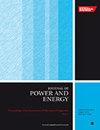超声波场对带肋表面 Al2O3 纳米流体池沸腾传热的影响
IF 1.1
4区 工程技术
Q3 ENGINEERING, MECHANICAL
Proceedings of the Institution of Mechanical Engineers, Part A: Journal of Power and Energy
Pub Date : 2024-08-02
DOI:10.1177/09576509241270837
引用次数: 0
摘要
纳米流体是解决微尺度传热和传质问题以强化池沸腾传热的常用技术。本文研究了纳米流体、超声波场和肋片表面对池水沸腾传热协同强化的影响。采用两步法制备了不同浓度和直径的 Al2O3 纳米流体。分组实验分别考察了纳米流体浓度和直径、超声功率和距离以及肋片表面类型对传热特性的影响。热通量和对流传热系数是性能参数。结果表明,Al2O3 纳米流体的浓度和直径对池沸腾的传热性能有影响。当 Al2O3 纳米流体的浓度为 0.01 wt% 时,平均直径为 80 nm 的 Al2O3 纳米流体对水池沸腾传热性能的增强效果最显著,而直径为 30 nm 的 Al2O3 纳米流体的增强效果最弱。同时,超声波场产生的声流效应和空化效应可促进纳米流体池沸腾低过热阶段气泡的能量积累、破裂和再生。传热系数(HTC)随着超声场的变化而逐渐增大。在超声波功率为 528 W、距离为 50 mm 时,纳米流体池沸腾比无超声波场 HTC 提高了 44.34%。与无肋相比,肋 II 的 Al2O3 纳米流体池沸点在超声场下降低了 2°C。超声波场 p = 528 W 和肋骨 II 的纳米流体池沸腾的传热效果最好,HTC 提高了 50%以上。这是因为在 Rib II 的受热表面上增加了更多的气泡成核点。本文章由计算机程序翻译,如有差异,请以英文原文为准。
Effect of ultrasonic field on pool boiling heat transfer to Al2O3 nanofluid on ribbed surfaces
Nanofluid was frequent technique which solved microscale heat and mass transport problems to intensify pool boiling heat transfer. This paper had investigated the effect of nanofluid, ultrasonic field and ribs surfaces on cooperative heat transfer enhancement in pool boiling. A two-step method was applied to prepare Al2 O3 nanofluids of different kinds of concentrations and diameters. Group experiments were examined the influences of nanofluid concentration and diameter, ultrasonic power and distance and rib surface type on heat transfer characteristics, respectively. The heat flux and convection heat transfer coefficient were used the performance parameters. The results showed that the concentration and diameter of the Al2 O3 nanofluid effected the heat transfer performance on the pool boiling. The Al2 O3 nanofluid with an average diameter of 80 nm had the most significant enhancement effect on the pool boiling heat transfer performance, but the Al2 O3 with a diameter of 30 nm had the weakest enhancement effect, when the concentration of Al2 O3 nanofluid was 0.01 wt%. Meanwhile, the generated acoustic streaming effect and cavitation effect by ultrasonic field can promote the energy accumulation, rupture and regeneration of the bubbles at low superheat stage on nanofluid pool boiling. The heat transfer coefficient (HTC) gradually enhances as the ultrasonic field changes. At an ultrasonic power of 528 W and a distance of 50 mm, the nanofluid pool boiling increased by 44.34% compared to no ultrasonic field HTC. Compared with No rib, the boiling point of the Al2 O3 nanofluidic pool boiling of Rib II was reduced by 2°C under the ultrasonic field. The nanofluid pool boiling with ultrasonic field of p = 528 W and Rib II had the best heat transfer effect, and HTC improved more than 50%. This is due to the addition of more nucleation points for bubbles on the heated surface of the Rib II.
求助全文
通过发布文献求助,成功后即可免费获取论文全文。
去求助
来源期刊

CiteScore
3.30
自引率
5.90%
发文量
114
审稿时长
5.4 months
期刊介绍:
The Journal of Power and Energy, Part A of the Proceedings of the Institution of Mechanical Engineers, is dedicated to publishing peer-reviewed papers of high scientific quality on all aspects of the technology of energy conversion systems.
 求助内容:
求助内容: 应助结果提醒方式:
应助结果提醒方式:


